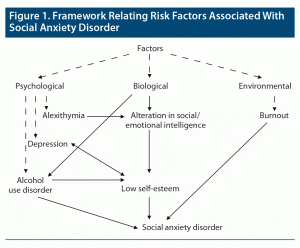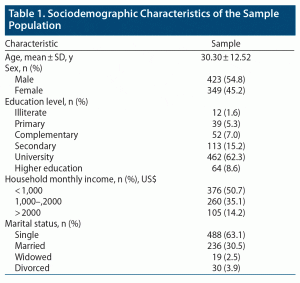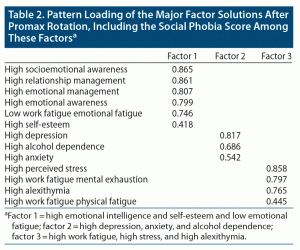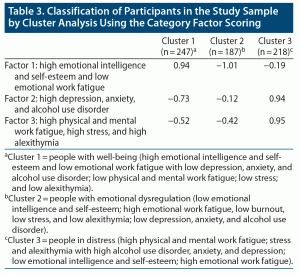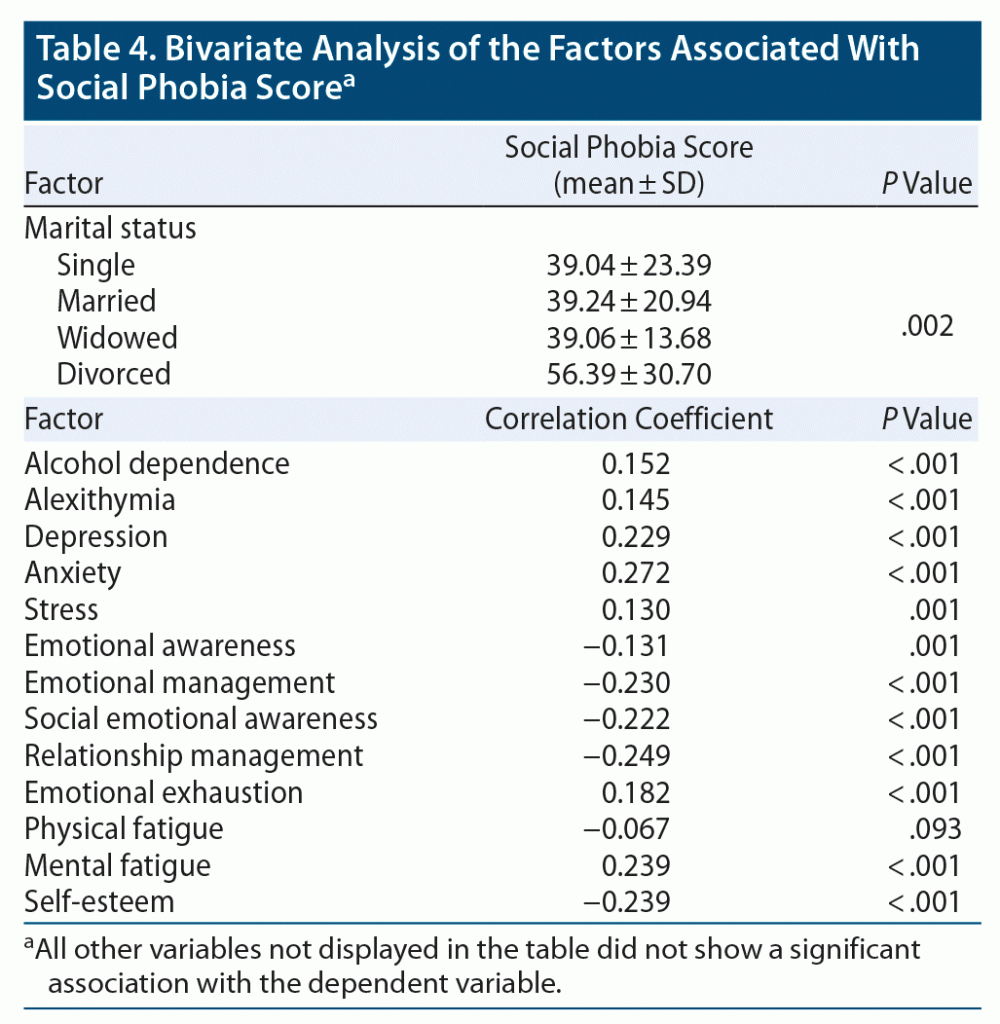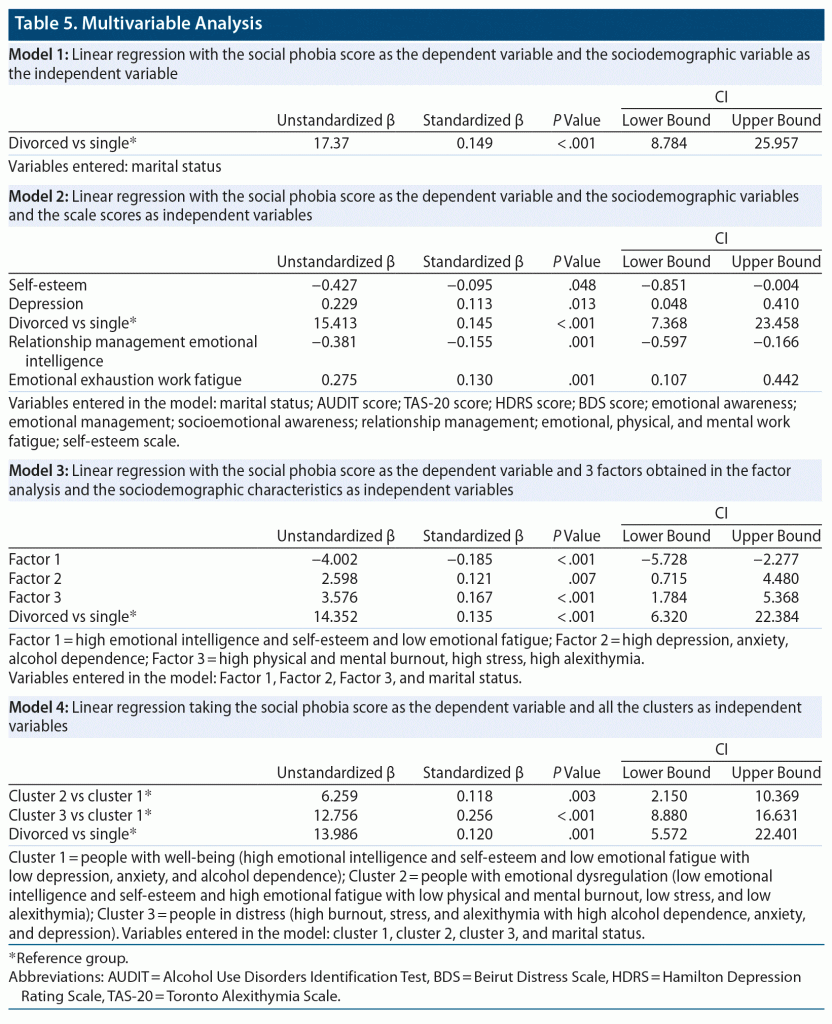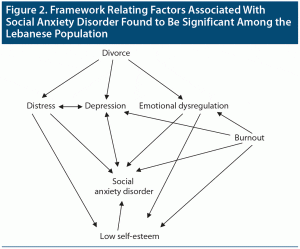ABSTRACT
Objective: To evaluate factors associated with social anxiety disorder among the Lebanese population, construct a new model associating these factors, and compare its uniformity with a theoretical framework.
Methods: A total of 789 participants were enrolled in this cross-sectional survey study. The Liebowitz Social Anxiety Scale was used to assess fear and avoidance. The study was conducted from November 2017 to March 2018.
Results: Depression (β = 0.229, P = .013), emotional exhaustion/work fatigue (β = 0.275, P = .001), and experiencing a divorce (β = 15.413, P < .001) were significantly associated with higher social phobia. Higher self-esteem (β = −0.427, P = .048) and higher relationship management (β = −0.381, P = .001) were significantly associated with lower social phobia.
Conclusions: This study provides crucial information about the psychological factors of social anxiety among the Lebanese population. Divorce, depression, and emotional exhaustion/work fatigue were associated with higher social anxiety. Low self-esteem and better relationship management were associated with lower social anxiety. Psychotherapy interventions may be beneficial to reduce depression and work fatigue and improve emotional intelligence and self-esteem.
Prim Care Companion CNS Disord 2022;24(1):20m02902
To cite: Fares K, Haddad C, Malaeb D, et al. Social anxiety and its correlates among Lebanese adults: role of self-esteem, depression, alcohol use disorder, alexithymia, and work fatigue. Prim Care Companion CNS Disord. 2022;24(1):20m02902.
To share: https://doi.org/10.4088/PCC.20m02902
© Copyright 2022 Physicians Postgraduate Press, Inc.
aFaculty of Arts and Sciences, Holy Spirit University of Kaslik, Jounieh, Lebanon
bResearch Department, Psychiatric Hospital of the Cross, Jal Eddib, Lebanon
cUniversité de Limoges, Neuroépidémiologie Tropicale, Institut d’Epidémiologie et de Neurologie Tropicale, Limoges, France
dINSPECT-LB (Institut National de Santé Publique, d’Épidémiologie Clinique et de Toxicologie-Liban), Beirut, Lebanon
eLife Sciences and Health Department, Paris-Est University, Paris, France
fSchool of Pharmacy, Lebanese International University, Beirut, Lebanon
gFaculty of Pharmacy, Lebanese University, Beirut, Lebanon
hUniversity of Nicosia Medical School, Nicosia, Cyprus
iFaculty of Medicine and Medical Sciences, Holy Spirit University of Kaslik, Jounieh, Lebanon
*Corresponding author: Souheil Hallit, PharmD, MSc, MPH, PhD, Faculty of Medicine and Medical Sciences, Holy Spirit University of Kaslik (USEK), Jounieh, Lebanon ([email protected]).
Social anxiety disorder, or social phobia, describes overwhelming anxiety and extreme fear in everyday public or performance events.1 Patients diagnosed with social anxiety disorder have an extreme fear of being criticized, watched by other individuals, and being humiliated or disgraced by their actions.2 The lifetime prevalence of social anxiety disorder ranges between 12.1% and 16% in the US population.3
The complexity of factors known to be associated with social anxiety disorder makes it more difficult to construct a model to understand this mental disorder.4 However, the biological, psychological, and environmental components remain the principal factors that explain the etiology of social anxiety disorder and may play a role in its development.5 With regard to the psychological factors, traumatic experiences and negative environments such as emotional, physical, sexual, or verbal abuse; criticism; neglect; violence; and divorce often cause people to develop negative beliefs and maladaptive behaviors that may develop into social anxiety disorder.6
High negative emotions are connected to depression, low self-esteem, and all anxiety disorders.7 Thus, people with low self-esteem may avoid social situations; it is not a fear of social criticism but a fear that they do not deserve the benefits of social interaction.6 Emotional intelligence, characterized by the ability to monitor self and others’ emotions, was shown to be altered in patients with social anxiety disorder.8 These patients may lack essential abilities such as the capacity to identify a person’s feelings and describe those feelings toward others and interpersonal competency skills such as decoding of other’s emotional expression.8
Furthermore, burnout, which is a type of stressor characterized by exhaustion and overwhelming tasks, seems to be interrelated to anxiety symptoms in persistent fatigue, but the difference was found in the ability to state and show emotions and feelings.9 Burnout is characterized by chronic fatigue syndrome that has an impact on daily functioning; this symptom is also common in depression and anxiety.
In addition, alexithymic individuals, characterized by emotional dysregulation, have impaired ability to promote feelings during internal or external events, particularly in social gatherings with high emotional consequences.10 Thus, a determined avoidance of interpersonal actions could cause perturbations and struggles in relationships and contribute to an increase in social anxiety symptoms.11
Alcohol use disorder (AUD) occurs among patients with social anxiety disorder.12 Alcohol dependence is preceded by social anxiety symptoms, and alcohol may be used by some to alleviate social anxiety manifestations and enhance social skills.13 However, some patients living with AUD may develop social anxiety symptoms due to the embarrassment of their actions.14
There are multiple proposed frameworks for SAD-related factors in the literature. In 2011, Nolte and colleagues15 demonstrated a model linking the attachment system, which joins biological, genetic, and environmental risk factors to stress and fear that develop into social anxiety. In 2016, Spence and Rapee16 described how the interaction of multiple extrinsic and intrinsic factors develops into social anxiety disorder. Similarly, in the present study, we created a theoretical framework relating psychological, biological, and environmental risk factors that are associated with social anxiety disorder (Figure 1) to better understand these correlations among the population of Lebanon. In this framework, we hypothesized the following relationships: (1) factors such as AUD and burnout might directly cause social anxiety disorder, (2) AUD resulting from biological perturbations can also induce social anxiety disorder, (3) alexithymia is correlated with altered emotional intelligence that causes low self-esteem and therefore social anxiety disorder, and (4) AUD and depression may lead to lower self-esteem directly linked to social anxiety disorder. We chose these factors because the correlation between them and social anxiety disorder was found in previous research6–14 to be statically significant.
In Lebanon, the economic state has always been fragile due to multiple reasons. Besides the political and religious conflicts, Lebanon shelters refugees of different nationalities, mainly Syrians and Palestinians. On the other hand, the long history of world and civil wars, famine, poverty, and epidemics has also had a harmful effect on the psychological health of the Lebanese population. More than half of the Lebanese population (adolescents and adults) were shown to have mental health issues, yet cases are not adequately reported.17–23 The Lebanese still feel ashamed to visit clinicians and seek treatment due to cultural reasons and social fears,24 which also worsens their social insecurities. Previously, the Institute for Development, Research, Advocacy and Applied Care reported that 1.9% of the Lebanese population, both male and female, have social anxiety disorder. Additional information concerning factors associated with social anxiety disorder might improve the skills of Lebanese physicians when caring for these patients.
Southeast Asian countries have more behavioral rules regarding social engagements compared to Western countries. Therefore, those from Eastern countries are more prone to embarrassment and guilt when breaking these rules, particularly in collectivistic countries that embrace group harmony and in individualistic countries that reward personal achievements.25 For example, Asia, South Europe, and the US have strict values and norms, which affect the mental health of individuals.26 Another aspect of the Western culture is the independent self-construal, wherein people tend to be distant from others and are autonomous. Asian and Eastern groups tend to maintain the integrity of the group and live in interdependent relationships.26 However, most reports on the impact of cultural norms on social anxiety expression have not shown statistical significance.27 The objective of this study was to evaluate factors associated with social anxiety disorder, mainly emotional intelligence, alexithymia, alcohol consumption, depression, anxiety, stress, and self-regard, among a Lebanese sample.
METHODS
Sampling and Data Collection
This cross-sectional survey spanned 6 months (November 2017 to March 2018), with 789 Lebanese residents joining the study from each governorate and region through a proportional arbitrary sampling. Of 950 questionnaires distributed, 789 (83.05%) were completed and collected. In Lebanon, multiple villages are joined together to form a Caza, which forms a governorate. Lebanon is divided into 8 governorates, and each governorate is allocated into districts (24 districts) and divided into villages. The sample was randomly chosen at a proportionate rate from Lebanon’s governorates. Two villages and the enrolled participants living there were chosen randomly. Simple randomization was used to pick the villages. Participants were enrolled proportionately according to the number of persons living in each region based on the Lebanon Central Agency of Statistics. All adults (> 18 years old) living in a household were eligible to participate if they met the inclusion criteria. No age/sex adjustment was made during the data collection process. The exclusion criteria included individuals with intellectual disability and dementia as reported by a family member. Personnel were trained to perform data collection with minimum interrater lack of consistency during interviews and with assurance of research quality. Each household was visited, and a face-to-face interview using a direct approach between the interviewer and the participant was conducted with those who agreed to take part in the study. Participants were free to accept or refuse to participate in the study; no financial reward was offered in exchange for participation. Previous studies from this project used the same methodology.23 The protocol of this study was approved by the Psychiatric Hospital of the Cross Ethics and Research Committee (HPC-013-2018). Written informed consent was signed by each participant.
Minimal Sample Size Calculation
Based on a study28 conducted in 2005, the predicted prevalence of social phobia among the population, in general, was set at 12.1%. A confidence level of 95% and a design effect of 2 required a minimum of 326 participants. The population survey calculation was performed with Epi Info (version 7.2).
Instruments and Procedures
The interview was centered around an Arabic questionnaire given that is the native language of the Lebanese. One section focused on the participants’ sociodemographic characteristics such as age, sex, household monthly income, marital status, education level, and the type of alcohol they usually drink. Another section covered different scales.
Liebowitz Social Anxiety Scale (LSAS). This self-administered scale comprises 24 items divided into 2 groups linked to performance anxiety (13 questions) and social situations (11 questions),29 with higher points showing higher social distress and social phobia.30 Research suggests that scores of 30 or less indicate an absence of social anxiety, 31–60 indicate probable social anxiety, 61–90 indicate very probable social anxiety, and 91 or more indicate highly probable social anxiety. According to this scoring, the LSAS total scale was categorized into 2 groups, absence of social anxiety (< 30) and presence of social anxiety (> 30) (Cronbach α for the total score is 0.954, for the fear subscale is 0.945, and for the avoidance subscale is 0.953).
Alcohol Use Disorders Identification Test (AUDIT). This self-administered scale comprises 10 items used to evaluate alcohol consumption.31 A score ≥ 8 classifies alcohol intake as dangerous (Cronbach α = 0.885).
Toronto Alexithymia Scale. This 20-item scale assesses alexithymia on a scale from 1 (strongly disagree) to 5 (strongly agree).32 Higher scores indicate a higher level of alexithymia (Cronbach α = 0.778).
Rosenberg Self-Esteem Scale. This 10-part scale evaluates the self-worth of an individual by considering both negative and positive feelings.33 Answers are graded from 1 (strongly agree) to 4 (strongly disagree). A high score indicates high self-esteem (Cronbach α = 0.733).
Hamilton Depression Rating Scale. The Hamilton Depression Rating Scale was translated into the Arabic language and proven to be valid.34 Higher scores indicate higher levels of depression (Cronbach α = 0.890).
Hamilton Anxiety Rating Scale. An Arabic version of the Hamilton Anxiety Rating Scale was validated35 and consists of 14 items. A score of 0 represents no present symptoms, while a score of 4 represents extremely severe symptoms. Anxiety severity increases as the score increases (Cronbach α = 0.898).
3-Dimensional Work Fatigue Inventory. Three types of work fatigue were evaluated via 6 questions each (18 questions total) with this instrument. Higher scores indicate greater fatigue. Scores of mental, emotional, and physical work fatigue36 range from 0 (never) to 4 (every day). In our study, the Cronbach α for those scores was 0.667, 0.909, and 0.823, respectively.
Beirut Distress Scale. This is a validated scale that assesses stress in the last month.37 Answers to 10 questions are graded from 0 (never) to 4 (very often); higher scores indicate higher stress (Cronbach α = 0.667).
Quick Emotional Intelligence Self-Assessment. This instrument comprises 4 domains: socioemotional awareness, emotional awareness, emotional management, and relationship management. In each part, 10 items are measured from 0 to 4 (0 = never and 4 = always). Higher scores indicate higher emotional intelligence.38 Here, the Cronbach α for the 4 domains (socioemotional awareness, emotional awareness, emotional management, and relationship management) was 0.902, 0.823, 0.888, and 0.908, respectively.
A mental health expert translated the original scale from English to Arabic, while a second specialist translated it back to English. The 2 English versions of this scale were compared; the initial version compared to the back-translated version showed no significant differences.
Statistical Analyses
To perform the data analysis, we used SPSS software version 23. Weighting to the general population was conducted using the variables sex, age, and governorate of dwelling. The official numbers of the Lebanese Ministry of Public Health were used.39 The independent-sample t test served as a method to compare 2 means, and analysis of variance was used to compare 3 or more means. Pearson correlation test was used to evaluate the association between the LSAS scores and other continuous variables. The LSAS score was set as the dependent variable, allowing us to conduct 4 stepwise linear regressions and a general linear model. Independent variables in all multivariable models were those with P values < .1 according to the bivariate analysis. A logistic regression was conducted using the LSAS dichotomy variable as the dependent variable.
Moreover, the scales’ reliability analysis relied on Cronbach α values. Results showing P values < .05 were classified as significant.
Analysis of factors and clusters can determine sample patterns. To classify these patterns, an exploratory evaluation of factors coupled with alexithymia was performed for the study sample. The extraction was conducted utilizing a Promax rotation. As for the sample’s adequacy, both Bartlett χ2 sphericity test and the index of Kaiser-Meyer-Olkin (KMO) were applied. An Eigenvalue ≥ 1 was a retention criterion for the factors. In this study, any item with a factor loading higher than 0.4 belonged to a certain factor. Then, a cluster analysis was executed with the help of the factor analysis results and the K-mean method chosen to recognize the different profiles of the participants, allowing for grouping of the contributors into 3 clusters.
RESULTS
The participants’ sociodemographic characteristics are summarized in Table 1. Of the participants, 45.2% were female, and the mean ± SD age was 30.30 ± 12.52 years. The results showed that 251 (35.9%) had no social anxiety, 312 (44.6%) had probable social anxiety, 124 (17.7%) had very probable social anxiety, and 12 (1.7%) had highly probable social anxiety.
Factor Analysis
The answers to all items centered around a solution of 3 factors (Factor 1 = high emotional intelligence, self-esteem, and low mental fatigue; Factor 2 = high depression, anxiety, and alcohol dependence; Factor 3 = high work fatigue, high stress, and high alexithymia), explaining 62.48% of the total variance (KMO = 0.866, Bartlett test of sphericity P < .001; Table 2).
Profiles of Participants
A 3-factor–based cluster analysis resulted in 3 unrelated clusters (cluster 1, cluster 2, cluster 3), which formed 37.9%, 28.7%, and 33.4% of all participants in the same order. The first cluster reflected individuals with well-being (high emotional intelligence and self-esteem and low emotional mental fatigue with low depression, anxiety, and alcohol use disorder). The second cluster represented those with emotional dysregulation (low emotional intelligence and self-esteem and high emotional work fatigue with low stress and low alexithymia). Cluster 3 represented people in distress (high physical and mental work fatigue, stress, and alexithymia with high alcohol use disorder, anxiety, and depression) (Table 3).
Bivariate Analysis
Social phobia was significantly higher in divorced participants (mean = 56.39) than in those who were single (mean = 39.04). Also, greater alcohol dependence was correlated with higher anxiety scores in both significant and positive manners (AUDIT score) (r = 0.152). A similar correlation was seen with more alexithymia (r = 0.145), depression (r = 0.229), anxiety (r = 0.272), stress (r = 0.130), emotional exhaustion (r = 0.182), and mental fatigue (r = 0.239). However, lower levels of social phobia were linked to higher self-esteem (r = −0.239), emotional awareness (r = −0.131), emotional management (r = −0.230), socioemotional awareness (r = −0.222), and relationship management (r = −0.249) (Table 4).
Multivariable Analysis
Four linear regression graphs were generated using the social phobia score as the dependent variable: (1) with the sociodemographic variable as independent variable, (2) with the sociodemographic variables and the scales as independent variables, (3) with the factors obtained in the factor analysis as independent variables, and (4) with the clusters obtained as independent variables.
The 4 resulting linear regression graphs showed that experiencing a divorce (β = 17.371) was significantly associated with higher social phobia. Depression (β = 0.229), burnout/emotional exhaustion (β = 0.275), and being divorced (β = 15.413) were significantly associated with higher social phobia, whereas higher self-esteem (β = −0.427) and higher relationship management (β = −0.381) were significantly associated with lower social phobia. Being divorced (β = 14.352), factor 2 (β = 2.598), and factor 3 (β = 3.576) were significantly associated with high social phobia prevalence, whereas factor 1 (β = −4.002) was significantly associated with lower social phobia. Also, being divorced (β = 13.986), cluster 2 (β = 6.259), and cluster 3 (β = 12.756) were significantly associated with higher social phobia (Table 5).
The results of a logistic regression using the LSAS dichotomy variable as the dependent variable showed similar results as the linear regression, wherein cluster 2 (adjusted odds ratio = 1.919) and cluster 3 (adjusted odds ratio = 6.554) were significantly associated with the presence of social phobia (Supplementary Table 1). The results of the general linear model were similar to those obtained in the linear regression (data not shown).
DISCUSSION
The results of this study helped us create a new model and confirmed the associations drawn in the theoretical model between all included factors. The resulting framework shown in Figure 2 was found to be compatible with theoretical models based on other populations (see Figure 1). This study will aid in understanding the underlying causes of social anxiety disorder. Such results are helpful when trying to diagnose complex disorders or when performing psychotherapy interventions to treat individuals with overlapping mental illnesses.
A hierarchical stepwise regression model showed that divorced state, having an emotional dysregulation (cluster 2), or being in distress (cluster 3) significantly increased social anxiety disorder in our study population. These results can be explained by several factors imposed on the Lebanese population: the numerous wars that have occurred in Lebanon, the political conflicts between parties, and the differences among 18 distinctive religions and their negative additional effect on the persistent economic crisis of the country.40
All these factors produced a high level of stress, depression, and emotional dysregulation and, therefore, placed individuals at higher risk of experiencing a mental disorder.41 Also, such events contribute to financial issues, which have been found to be a major reason behind disagreements and divorce among couples.42 It has been reported that divorced couples exhibit more symptoms of depression and psychological distress.43 Troxel and Matthews44 proposed a model that indicated a correlation between familial, physiologic, and social weakness in children with divorced parents and emotional dysregulation.44 Thus, individuals experiencing this emotional discomfort are also at risk of other psychological illnesses.41 In particular, adolescents from families with divorced parents had a higher level of anxiety.45 These results can be applied to our population wherein social anxiety disorder was found to be more common in divorced individuals. In contrast, previous research showed the opposite findings.46 However, this discrepancy can be clarified by noting that social anxiety affects most aspects of daily living and is associated with disability and avoidance of a broad range of everyday activities.
Our findings indicate that depression was more common in those with social anxiety. The cooccurrence of social anxiety and depressive illness is highly associated with added distress, social dysfunction, and isolation. Social anxiety symptoms usually precede depression symptoms and initiate a cycle of psychopathologic manifestations.47 Some individuals are likely to be more sensitive to such events than others and react to social interactions as a threat by experiencing a prolonged negative affect. Individuals may be involved in a post-event consideration process wherein they evoke and examine their own and others’ actions in the event.48 This unconstructive self-evaluation is likely to preserve or deepen negative feelings that could lead to social anxiety disorder.48 In contrast to our results, a study49 conducted on adult outpatients receiving therapy for social anxiety disorder found that 53% had previous periods of a depressive disorder, and patients with a mean age of 33 years had 2.2 episodes of depression on average in this cohort. These 2 distinguishable illnesses, depression and social anxiety, differ in symptoms but overlap with each other.50 Many people diagnosed with depression had a co-occurring anxiety disorder with social phobia being the most frequently encountered diagnosis.50 On the other hand, a psychological illness more commonly evolves in patients suffering from advanced social anxiety by almost 6-fold.50
In the present study, high emotional intelligence was related to a decrease in social phobia, which is consistent with other findings that explained a link between emotional intelligence and relationship success, solid attachment, achievement of well-being, and, especially, overall life satisfaction and joyfulness.8 As mentioned earlier, relational disagreements can influence everyday mood and self-confidence.51 People with high social skills would have the ability to manage their self-emotional situation during public events. Such interpersonal skills would decrease situational distress and reduce interaction anxiety.52
Our study underscores significant associations between the symptoms of social anxiety and emotional burnout, in line with data from previously published literature.53 It has been shown that higher emotional exhaustion is linked to mental health issues.54 Usually, workers at risk of experiencing emotional energy deficiency are those who work hard and fail to reach the desired achievements. This pressure and pessimistic view concerning oneself can eventually lead to psychological problems such as depression and social anxiety.52
Concerning the correlation between social anxiety disorder and self-regard, our study results show that patients with social anxiety tend to have low levels of self-esteem. Self-esteem has been linked to both public performance and stress defiance, and if sufficiently low, leaves individuals more prone to develop social anxiety.55 Previous meta-analytic research explored the effect of self-esteem on social relationships and found that high levels of perceived regard improve social skills and interpersonal engagement.51
Clinical and Public Health Implications
The findings of this study and the suggested framework focus on the contribution of numerous risk factors that make individuals more prone to social anxiety. These factors should be considered by clinicians who treat patients diagnosed with social anxiety disorder, along with prescribed medications if needed. Improvement of underlying psychological health issues such as low self-esteem, depression, and insufficient emotional skills can provide a remedy for social anxiety symptoms. Taken together, these cross-national data emphasize the international, clinical, and public health significance of social anxiety disorder. Health care professionals who are confident in their ability to distinguish symptoms will be better able to treat their patients according to guidelines compared to those unable to distinguish such symptoms.56 In other words, starting from such a background, the physicians can differentiate between an individual with social anxiety disorder and a healthy person. In addition, recognition of potential comorbid health problems associated with social anxiety disorder at earlier stages can improve treatment outcome. Our work can also help other researchers to enhance models addressing social anxiety disorder and to resolve its complex factors. Similar frameworks can be created to study other mental illnesses with overlapping factors. Finally, mental health must be made a global priority; one of the key measures to ensure this is through increasing the investment in mental health by policymakers, development agencies, national and international agencies, and other stakeholders. A psychosocial care network should be developed, along with stepwise training of health care professionals, expansion of services in isolated regions, and strengthening of existing resources, to maintain continuous support for subjects with social anxiety disorder, and innovative solutions should be adopted.
Limitations
Our findings cannot be generalized to include the entire population due to the predominance of young, single, and university-level educated participants. A cross-sectional study depends on a design that does not allow deductions concerning causes, temporality, and effects but focuses on associations between effects and explanatory variables alone. Our methods studied existing psychopathological symptoms and did not assess parameters like the age at onset of social anxiety disorder. Invalid scales are written in the Arabic language, possibly incurring a measurement bias. In addition, this study is retrospective and observational, which imposes consequences such as lower evidence levels and higher risks of information-related bias (overestimation of results of some recognized risk factors, difficulties in comprehending questions and remembering things). Recently, the Lebanese population experienced numerous distressing events: a major economic and currency crisis, the coronavirus disease 2019 pandemic and lockdowns, higher poverty rates, and the explosion in Beirut. Our study was conducted between 2017 and 2018 and therefore lacks data related to the traumatizing incidents of the past 2 years. Newer data collection should be performed.
CONCLUSION
In summary, the present study provides crucial information about the psychological factors of social anxiety among the Lebanese population. Divorce, depression, and emotional work fatigue were found to be associated with higher incidence of social anxiety. Low self-esteem and better relationship management were shown to be associated with lower incidence of the disorder. Psychotherapy interventions might be beneficial to reduce depression and burnout and to improve emotional intelligence, self-esteem, and many other factors related to social anxiety. However, it remains necessary to conduct further intervention studies testing the function of psychological factors to reduce social phobia among the Lebanese people.
Submitted: December 22, 2020; accepted April 5, 2021.
Published online: January 13, 2022.
Potential conflicts of interest: None.
Funding/support: None.
Acknowledgments: The authors thank all study participants.
Supplementary material: See accompanying pages.
Clinical Points
- Physicians should recognize potential comorbid health problems associated with social anxiety disorder at earlier stages.
- Improving underlying psychological issues such as low self-esteem, depression, and insufficient emotional skills can reduce social anxiety symptoms.
References (56)

- Schneier FR. Clinical practice. Social anxiety disorder. N Engl J Med. 2006;355(10):1029–1036. PubMed CrossRef
- American Psychiatric Association. Diagnostic and Statistical Manual for Mental Disorders. Fifth Edition. Washington, DC: American Psychiatric Association; 2013.
- Ruscio AM, Brown TA, Chiu WT, et al. Social fears and social phobia in the USA: results from the National Comorbidity Survey Replication. Psychol Med. 2008;38(1):15–28. PubMed CrossRef
- Hidalgo RB, Barnett SD, Davidson JR. Social anxiety disorder in review: two decades of progress. Int J Neuropsychopharmacol. 2001;4(3):279–298. PubMed CrossRef
- Dalrymple KL. Issues and controversies surrounding the diagnosis and treatment of social anxiety disorder. Expert Rev Neurother. 2012;12(8):993–1008, quiz 1009. PubMed CrossRef
- Brook CA, Schmidt LA. Social anxiety disorder: a review of environmental risk factors. Neuropsychiatr Dis Treat. 2008;4(1):123–143. PubMed
- Epkins CC, Heckler DR. Integrating etiological models of social anxiety and depression in youth: evidence for a cumulative interpersonal risk model. Clin Child Fam Psychol Rev. 2011;14(4):329–376. PubMed CrossRef
- Summerfeldt LJ, Kloosterman PH, Antony MM, et al. Social anxiety, emotional intelligence, and interpersonal adjustment. J Psychopathol Behav Assess. 2006;28(1):57–68. CrossRef
- van Dam A. Subgroup analysis in burnout: relations between fatigue, anxiety, and depression. Front Psychol. 2016;7:90. PubMed CrossRef
- Bilotta E, Giacomantonio M, Leone L, et al. Being alexithymic, necessity or convenience: negative emotionality × avoidant coping interactions and alexithymia. Psychol Psychother. 2016;89(3):261–275. PubMed CrossRef
- Franz M, Schaefer R, Schneider C, et al. Visual event-related potentials in subjects with alexithymia: modified processing of emotional aversive information? Am J Psychiatry. 2004;161(4):728–735. PubMed CrossRef
- Schneier FR, Foose TE, Hasin DS, et al. Social anxiety disorder and alcohol use disorder co-morbidity in the National Epidemiologic Survey on Alcohol and Related Conditions. Psychol Med. 2010;40(6):977–988. PubMed CrossRef
- Bulley A, Miloyan B, Brilot B, et al. An evolutionary perspective on the co-occurrence of social anxiety disorder and alcohol use disorder. J Affect Disord. 2016;196:62–70. PubMed CrossRef
- Olgiati P, Liappas I, Malitas P, et al. Depression and social phobia secondary to alcohol dependence. Neuropsychobiology. 2007;56(2–3):111–118. PubMed CrossRef
- Nolte T, Guiney J, Fonagy P, et al. Interpersonal stress regulation and the development of anxiety disorders: an attachment-based developmental framework. Front Behav Neurosci. 2011;5:55. PubMed CrossRef
- Spence SH, Rapee RM. The etiology of social anxiety disorder: an evidence-based model. Behav Res Ther. 2016;86:50–67. PubMed CrossRef
- Obeid S, Akel M, Haddad C, et al. Factors associated with alexithymia among the Lebanese population: results of a cross-sectional study. BMC Psychol. 2019;7(1):80. PubMed CrossRef
- Sfeir E, Geara C, Hallit S, et al. Alexithymia, aggressive behavior and depression among Lebanese adolescents: a cross-sectional study. Child Adolesc Psychiatry Ment Health. 2020;14(1):32. PubMed CrossRef
- Merhy G, Azzi V, Salameh P, et al. Anxiety among Lebanese adolescents: scale validation and correlates. BMC Pediatr. 2021;21(1):288. PubMed CrossRef
- Zakhour M, Haddad C, Sacre H, et al. Suicidal ideation among Lebanese adults: scale validation and correlates. BMC Psychiatry. 2021;21(1):100. PubMed CrossRef
- Obeid S, Lahoud N, Haddad C, et al. Factors associated with anxiety among the Lebanese population: the role of alexithymia, self-esteem, alcohol use disorders, emotional intelligence and stress and burnout. Int J Psychiatry Clin Pract. 2020;24(2):151–162. PubMed CrossRef
- Chahine M, Salameh P, Haddad C, et al. Suicidal ideation among Lebanese adolescents: scale validation, prevalence and correlates. BMC Psychiatry. 2020;20(1):304. PubMed CrossRef
- Obeid S, Lahoud N, Haddad C, et al. Factors associated with depression among the Lebanese population: results of a cross-sectional study. Perspect Psychiatr Care. 2020;56(4):956–967. PubMed CrossRef
- Karam EG, Mneimneh ZN, Dimassi H, et al. Lifetime prevalence of mental disorders in Lebanon: first onset, treatment, and exposure to war. PLoS Med. 2008;5(4):e61. PubMed CrossRef
- Hofmann SG, Anu Asnaani MA, Hinton DE. Cultural aspects in social anxiety and social anxiety disorder. Depress Anxiety. 2010;27(12):1117–1127. PubMed CrossRef
- Hofmann SG, Hinton DE. Cross-cultural aspects of anxiety disorders. Curr Psychiatry Rep. 2014;16(6):450. PubMed CrossRef
- Woody SR, Miao S, Kellman-McFarlane K. Cultural differences in social anxiety: a meta-analysis of Asian and European heritage samples. Asian Am J Psychol. 2015;6(1):47–55. CrossRef
- Kessler RC, Chiu WT, Demler O, et al. Prevalence, severity, and comorbidity of 12-month DSM-IV disorders in the National Comorbidity Survey Replication. Arch Gen Psychiatry. 2005;62(6):617–627. PubMed CrossRef
- Liebowitz MR. Social phobia. Mod Probl Pharmacopsychiatry. 1987;22:141–173. PubMed CrossRef
- Rytwinski NK, Fresco DM, Heimberg RG, et al. Screening for social anxiety disorder with the self-report version of the Liebowitz Social Anxiety Scale. Depress Anxiety. 2009;26(1):34–38. PubMed CrossRef
- Bohn MJ, Babor TF, Kranzler HR. The Alcohol Use Disorders Identification Test (AUDIT): validation of a screening instrument for use in medical settings. J Stud Alcohol. 1995;56(4):423–432. PubMed CrossRef
- Bagby RM, Parker JD, Taylor GJ. The twenty-item Toronto Alexithymia Scale, I: item selection and cross-validation of the factor structure. J Psychosom Res. 1994;38(1):23–32. PubMed CrossRef
- Rosenberg M. Society and the Adolescent Self-Image. Princeton University Press; 1965.
- Obeid S, Abi Elias Hallit C, Haddad C, et al. Validation of the Hamilton Depression Rating Scale (HDRS) and sociodemographic factors associated with Lebanese depressed patients. Encephale. 2018;44(5):397–402. PubMed CrossRef
- Hallit S, Haddad C, Hallit R, et al. Validation of the Hamilton Anxiety Rating Scale and State Trait Anxiety Inventory A and B in Arabic among the Lebanese population. Clin Epidemiol Glob Health. 2020;8(4):1104–1109. CrossRef
- Frone MR, Tidwell MO. The meaning and measurement of work fatigue: development and evaluation of the Three-Dimensional Work Fatigue Inventory (3D-WFI). J Occup Health Psychol. 2015;20(3):273–288. PubMed CrossRef
- Malaeb D, Farchakh Y, Haddad C, et al. Validation of the Beirut Distress Scale (BDS-10), a short version of BDS-22, to assess psychological distress among the Lebanese Population [published online ahead of print April 6, 2021]. Perspect Psych Care. PubMed CrossRef
- Mohapel P. The Quick Emotional Intelligence Self-Assessment. San Diego City College MESA Program.
- Demographic and Social Population Statistics. Presidency of the council of Ministers, Central Administration of Statistics, Lebanese Republic. Accessed December 21, 2021. http://www.cas.gov.lb/index.php/demographic-and-social-en/population-en
- Baumann H. The causes, nature, and effect of the current crisis of Lebanese capitalism. Nationalism Ethn Polit. 2019;25(1):61–77. CrossRef
- Ajrouch KJ, Abdulrahim S, Antonucci TC. Stress, social relations, and psychological health over the life course. GeroPsych (Bern). 2013;26(1):15–27. CrossRef
- Poduska BE, Allred GH. Family finances: the missing link in MFT training. Am J Fam Ther. 1990;18(2):161–168. CrossRef
- Williams K. Has the future of marriage arrived? a contemporary examination of gender, marriage, and psychological well-being. J Health Soc Behav. 2003;44(4):470–487. PubMed CrossRef
- Troxel WM, Matthews KA. What are the costs of marital conflict and dissolution to children’s physical health? Clin Child Fam Psychol Rev. 2004;7(1):29–57. PubMed CrossRef
- Tahirović S, Demir G. Influence of Parental Divorce on Anxiety Level of Adolescents. Contemporary Perspective on Child Psychology and Education. IntechOpen; 2017.
- Grant BF, Hasin DS, Stinson FS, et al. The epidemiology of DSM-IV panic disorder and agoraphobia in the United States: results from the National Epidemiologic Survey on Alcohol and Related Conditions. J Clin Psychiatry. 2006;67(3):363–374. PubMed CrossRef
- Bunevicius R, Liaugaudaite V, Peceliuniene J, et al. Factors affecting the presence of depression, anxiety disorders, and suicidal ideation in patients attending primary health care service in Lithuania. Scand J Prim Health Care. 2014;32(1):24–29. PubMed CrossRef
- Farmer AS, Kashdan TB. Stress sensitivity and stress generation in social anxiety disorder: a temporal process approach. J Abnorm Psychol. 2015;124(1):102–114. PubMed CrossRef
- Chartier MJ, Walker JR, Stein MB. Considering comorbidity in social phobia. Soc Psychiatry Psychiatr Epidemiol. 2003;38(12):728–734. PubMed CrossRef
- Tiller JW. Depression and anxiety. Med J Aust. 2013;199(S6):S28–S31. PubMed
- Harris MA, Orth U. The link between self-esteem and social relationships: a meta-analysis of longitudinal studies. J Pers Soc Psychol. 2020;119(6):1459–1477. PubMed CrossRef
- Mousavi SV, Ramezani M, Salehi I, et al. The relationship between burnout dimensions and psychological symptoms (depression, anxiety and stress) among nurses. J Holistic Nursing Midwifery. 2017;27(2):37–43. CrossRef
- Oosterholt BG, Maes JH, Van der Linden D, et al. Cognitive performance in both clinical and non-clinical burnout. Stress. 2014;17(5):400–409. PubMed CrossRef
- Hamid N, Charkhabi M, Amanollah Nejad M. Relationship between dimensions of burnout and mental health in physicians of hospitals affiliated in Ahvaz Jundishapur University. J Modr Indus Org Psy. 2011;2(6):9–16.
- Hansson L. Determinants of quality of life in people with severe mental illness. Acta Psychiatr Scand suppl. 2006;113(429):46–50. PubMed CrossRef
- Smolders M, Laurant M, Verhaak P, et al. Which physician and practice characteristics are associated with adherence to evidence-based guidelines for depressive and anxiety disorders? Med Care. 2010;48(3):240–248. PubMed CrossRef
Please sign in or purchase this PDF for $40.
